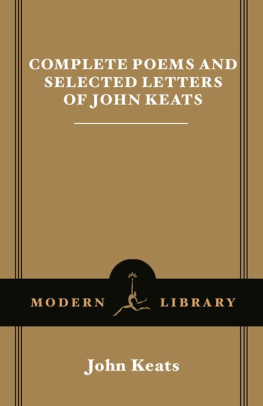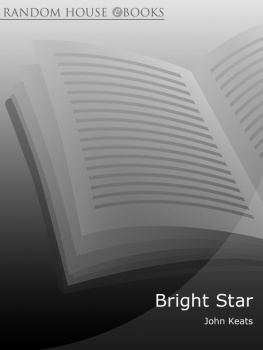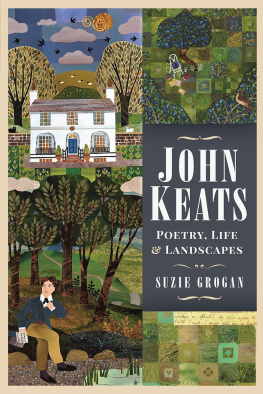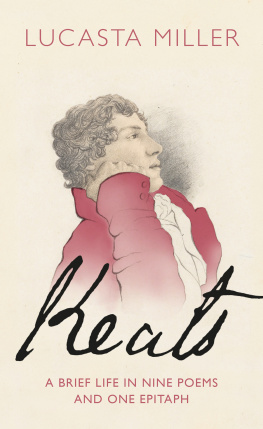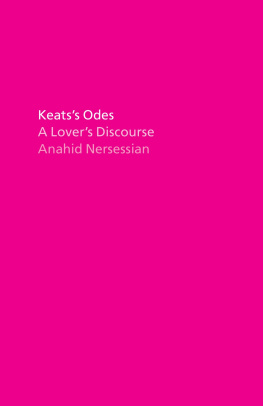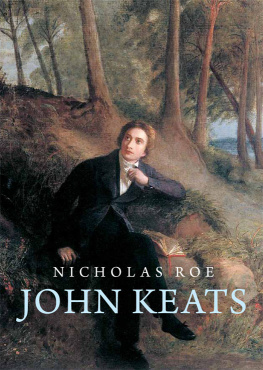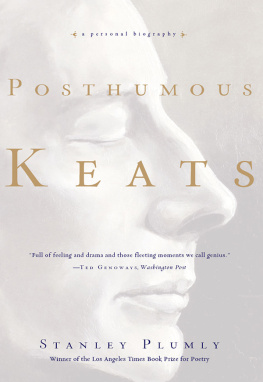John Keats - Complete Poems and Selected Letters of John Keats
Here you can read online John Keats - Complete Poems and Selected Letters of John Keats full text of the book (entire story) in english for free. Download pdf and epub, get meaning, cover and reviews about this ebook. year: 2001, genre: Art. Description of the work, (preface) as well as reviews are available. Best literature library LitArk.com created for fans of good reading and offers a wide selection of genres:
Romance novel
Science fiction
Adventure
Detective
Science
History
Home and family
Prose
Art
Politics
Computer
Non-fiction
Religion
Business
Children
Humor
Choose a favorite category and find really read worthwhile books. Enjoy immersion in the world of imagination, feel the emotions of the characters or learn something new for yourself, make an fascinating discovery.
- Book:Complete Poems and Selected Letters of John Keats
- Author:
- Genre:
- Year:2001
- Rating:4 / 5
- Favourites:Add to favourites
- Your mark:
- 80
- 1
- 2
- 3
- 4
- 5
Complete Poems and Selected Letters of John Keats: summary, description and annotation
We offer to read an annotation, description, summary or preface (depends on what the author of the book "Complete Poems and Selected Letters of John Keats" wrote himself). If you haven't found the necessary information about the book — write in the comments, we will try to find it.
Complete Poems and Selected Letters of John Keats — read online for free the complete book (whole text) full work
Below is the text of the book, divided by pages. System saving the place of the last page read, allows you to conveniently read the book "Complete Poems and Selected Letters of John Keats" online for free, without having to search again every time where you left off. Put a bookmark, and you can go to the page where you finished reading at any time.
Font size:
Interval:
Bookmark:

J OHN K EATS
John Keats was born in London in living quarters connected with his maternal grandfathers livery stable, the Swan and Hoop Inn, on October 31, 1795. He was the eldest of five children (one of whom died in infancy) begot by Thomas and Frances Jennings Keats. His father was the chief hostler at the Swan and Hoop, and the family prospered. The boy was eight years old when Thomas Keats was killed in a riding accident; the next year, in 1805, Keatss grandfather died. When the future poet was fourteen, his mother (after an unsuccessful remarriage) succumbed to tuberculosis. By then, however, Keats had received a liberal education at the progressive Clarke school, a private academy in the village of Enfield, twelve miles north of London, where for eight years he studied English literature, modern languages, and Latin. (He began translating Virgils Aeneid while still at school.) Charles Cowden Clarke, the headmasters son, remembered him as an outgoing youth who made friends easily and fought passionately in their defense. A fellow student recalled his pugnacious spirit: Keats was not in childhood attached to books. His penchant was for fighting. He would fight any one. Yet George Keats spoke of his brothers nervous, morbid temperament (perhaps attributable to a complex about being shortpoor little Johnny Keats was barely five feet tall) and of his having many a bitter fit of hypochondriasm. Indeed Keats himself wrote: My mind has been the most discontented and restless one that ever was put into a body too small for it.
In 1811 Keats left the Clarke school to become a surgeons apprenticefirst at Thomas Hammonds apothecary shop in a small town near Enfield and later in London at Guys Hospital. (Surgery would have been a respectable and reasonable calling for someone of Keatss means: unlike the profession of medicine, it did not require a university degree. Moreover, Keats always maintained he was ambitious of doing the world some good.) During his five years of study for a license, the young apprentice completed his translation of the Aeneid and devoured rather than read Ovids Metamorphoses, Miltons Paradise Lost, and other books he borrowed from the Clarke school. But the work that decisively awakened his love of poetryindeed shocked him suddenly into self-awareness of his own powers of imaginationwas Edmund Spensers Faerie Queene. At some point in 1814 Keats composed his first poem, In Imitation of Spenser. Although he struck medical colleagues as an idle loafing fellow, always writing poetry, on July 25, 1816, Keats passed the apothecaries examination that allowed him to practice surgery.
In the meantime, his poetic genius was being recognized and encouraged by early friends like Charles Cowden Clarke and J. H. Reynolds, and in October 1816 Clarke introduced him to Leigh Hunt, whose Examiner, the leading liberal magazine of the day, had recently published Keatss sonnet O Solitude. Five months later, on March 3, 1817, Poems, his first volume of verse, appeared. Despite the high hopes of the Hunt circle, it was a failure. During the fall of that year, Keats stayed with Oxford student Benjamin Bailey at Magdalen College. While Bailey crammed for exams, Keats worked on Endymion, his four-thousand-line romantic allegory; the two read and discussed Wordsworth, Hazlitt, Milton, Dante, and Shakespeare. Back in London, on November 22, 1817, Keats wrote to Bailey the first of his famous letters to friends (and siblings) on aesthetics, the social role of poetry, and his own sense of poetic mission. Rarely has a poet left such a remarkable record of his thoughts on his own career and its relation to the history of poetry. (The letters also reveal the astonishing speed with which Keats matured as an artist.) Yet by the time Endymion was published in April 1818, Keatss name had been identified with Hunts Cockney School, and the Tory Blackwoods Magazine delivered a violent attack on Keats as an ignorant and unsettled pretender to culture who had no right to aspire to poetry.
Although the critical reaction to Endymion was infamous for its ferocity, the youthful bard was hardly destroyed by itdespite Byrons famous quip that Keats was snuffed out by an Article. The surprising truth is that he entered upon an interval of astonishing productivity, perhaps the most concentrated period of creativity any English poet has ever known. In the summer of 1818, Keats journeyed to Scotland with Charles Brown, the rugged, worldly businessman who was one of his most loyal friends. There he vowed: I shall learn poetry here and shall henceforth write more than ever. That fall he began composing Hyperion, his imitation of and challenge to Miltons Paradise Lost; even critics saw the work as a major achievement. In December, following his brother Toms death from tuberculosis, Keats went to live with Charles Brown in Wentworth Place, Hampstead. There, almost in spite of himself, the young poet fell helplessly in love with Fanny Brawne, the eighteen-year-old daughter of a widowed neighbor; a year later they were betrothed. In 1819 Keats produced The Eve of St. Agnes, La Belle Dame sans Merci, the major odes, Lamia, the Dantean dream-vision The Fall of Hyperion, and the five-act verse tragedy Otho the Great (written in collaboration with Brown).
On February 3, 1820, Keats suffered a pulmonary hemorrhage that signaled an advanced stage of tuberculosis. He quickly broke off his engagement and began what he called a posthumous existence. His career as a poet was effectively ended, although the volume Lamia, Isabella, The Eve of St. Agnes, and Other Poems, containing the bulk of Keatss claim to immortality, was published that July. In a desperate attempt to recover his health in a milder climate, Keats sailed for Italy in September accompanied by the painter Joseph Severn. Declining an invitation to stay with Shelley in Pisa, the two arrived in Rome on November 15 and took up residence in rooms overlooking the Piazza di Spagna. John Keats died in Rome on the night of February 23, 1821, and was buried there on February 26 in the Protestant Cemetery. On his deathbed Keats requested that his tombstone bear no name, only the words Here lies one whose name was writ in water.
C ONTENTS
I NTRODUCTION
Edward Hirsch
John Keatss poems and letters were for meas they have been for so many others over the past two centuriesthe portals of poetry itself, the highly decorated doors through which one passed into a magisterial kingdom, a realm of pure feeling, passionate thought. I am certain of nothing but of the holiness of the Hearts affections and the truth of Imagination, Keats wrote to Benjamin Bailey in November 1817. What the imagination seizes as Beauty must be truth. This is the sort of certainty that announces a vocationit helped to seal mineand opens the pathway to a lifes work. The Imagination may be compared to Adams dream, Keats continued, he awoke and found it truth. So many of Keatss formulations are like a bell, a trumpet call, leading us to our deepest, most imaginative selves.
Keats believed that the excellence of every Art is its intensity. One discovers in the luxuriant lyric spaces of his art that the emotions are deemed sacred and the daydreaming capacities of the mind are given free rein to join with a feverishly active consciousness, with what he calls in Ode to Psyche a working brain. He left ample room in his poems for reverie and trance, for waking into a slumberous tenderness (The Eve of St. Agnes), and he combined that associative drift with a startling openheartedness and a ferocious working intellect, the mind of a maker. He believed in the essential healthiness of the lyricthe healing powers of artand early on borrowed a metaphor from medicine to declare that poetry itself should be a friend/To soothe the cares, and lift the thoughts of man (Sleep and Poetry).
Next pageFont size:
Interval:
Bookmark:
Similar books «Complete Poems and Selected Letters of John Keats»
Look at similar books to Complete Poems and Selected Letters of John Keats. We have selected literature similar in name and meaning in the hope of providing readers with more options to find new, interesting, not yet read works.
Discussion, reviews of the book Complete Poems and Selected Letters of John Keats and just readers' own opinions. Leave your comments, write what you think about the work, its meaning or the main characters. Specify what exactly you liked and what you didn't like, and why you think so.

